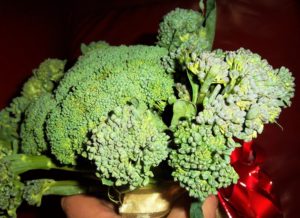What broccoli, thyroid and taste have in common?
Cruciferous vegetables such as broccoli, cabbage, broccolini, mustard greens, cauliflower, kohlrabi, turnip, radish, kale and watercress are great for us. We should include them in our diet. They have many beneficial health effects as they contains plenty of beneficial nutrients, have detoxifying and anti-carcinogenic effects. Cruciferous vegetables are very important for glutathione function (important detoxifying molecule) and removal of many toxins from the body, including heavy metals.
Most cruciferous vegetables are also mild goitrogens. They contain compounds such as isoflavones and isothiocyanates. Those molecules are natural mild thyroid inhibitors with action similar to antithyroid medications used for hyperthyroidism.
Goitrogenic food normally does not hamper the thyroid hormone production in healthy individuals. However, in excessive amounts, believed to be more than two cups a day of raw food, they can slow down the thyroid function. People with a sluggish thyroid may be affected when consuming high amounts of goitrogenic vegetables (especially raw ones) especially if they do not have enough iodine in their diet. Cooking these foods destroys most of the antithyroid chemical. However they would still benefit from having some cruciferous foods, just not in excessive amounts. Those with sluggish thyroid should have adequate iodine levels.
People with Graves’ disease may benefit from eating goitrogenic vegetables. As these vegetables work mildly like antithyroid medications, people who take antithyroid medications might need a lower dose of medication when consuming high amounts (about two cups per day) of raw goitrogenic food. Eating more goitrogens may be used as a remedy to improve symptoms of Graves’ disease. Some goitrogenic food like broccoli induces the enzyme CYP1A, which is involved in metabolising the active vitamin D3 and estrogen, which might benefit someone with GD. CYP1A enzyme might be down regulated in a Graves’ disease process. I came across the comparison of goitrogenic foods in some literature to double edged sword as you might lower the production of thyroid hormones but enlarge the thyroid gland. Therefore over excessive and long term overeating of these foods might backfire. However during periods of hyperthyroidism it may be beneficial to increase consumption of goitrogenic foods.
Speak to your doctor regarding those issues and changes to your diet.
Goitrogenic food competes with thyroid gland with the uptake of iodine from the blood. The compounds in goitrogenic food bind to NIS receptor on thyroid cells and prevent iodine transport into those cells. Iodine is essential for thyroid hormone production. For example, highly goitrogenic food like cassava root and cassava flour, consumed in high amounts in Africa was shown to interfere with the thyroid function.
When goitrogenic foods are chewed, Indole-3-Carbinol, glucose, and thiocyanate ion are generated. Indole-3-carbinol is broken down in the body to Diindolylmethane (DIM), which might help with oestrogen and thyroid hormone metabolism in peripheral tissues by lowering aromatase enzyme activity and thus might help in a relative androgen deficiency and estradiol excess, which is sometimes found in autoimmune disorders. Increased aromatase activity in Graves’ disease may cause Gynecomastia (enlarged breasts) in men and DIM from cruciferous vegetables may help. Other natural aromatase inhibitors are: passionflower tea, chamomile, quercentin, flaxseed oil, lemons, oranges, olive leaf extract and red wine (or red grapes). DIM (Diindolylmethane) is available as supplement. However, there are no scientific studies done on the use of DIM for Graves’ disease and therefore at the present time it’s too early to talk about its benefits vs. risks in regards to this illness.
Other goitrogenic foods include: Brussels sprouts, celery, corn, horseradish, peanuts, almonds, millet, pine nuts, bamboo shoots, sweet potatoes, lima beans, cassava and walnuts. There are cruciferous food powder concentrates on the market, which can be used in drinks or added to shakes and juices. This may make it easier for some people.
Mildly goitrogenic food examples include spinach, strawberries, peaches, apricots, cherries and pears.
It is best to pick cruciferous food you can tolerate as some people may experience bloating or digestive discomfort with some cruciferous foods such as broccoli or cabbage.
PTC (phenylthiocarbamide) is a goitrogenic like substance and PTC- like chemicals are present in goitrogenic foods. It is often used in genetic traits studies at schools in a form of taste paper saturated in PTC. There are PTC taste papers available on the market. Some people taste PTC strongly (very bitter), some mildly (slightly bitter) and others report no taste at all.
The trait of tasters or non-tasters of PTC is genetically inherited and believed to be connected to HLA genes. Those genes are also involved in autoimmunity predisposition.
I found it interesting that there are much more PTC tasters amongst people with Graves’ disease and they can taste lower levels of (PTC) than people with other type of hyperthyroidism (1, 2). On the other hand, people with hypothyroidism tend to be non-tasters. Perhaps, people who can taste bitterness of some goitrogenic compounds have enormous benefits from eating those goitrogenic foods. I can taste PTC. The trait of PTC taster or non-taster may perhaps be some indication of the predisposition to GD.
Our bodies are amazing. Our taste, food preferences, its benefits for our individual health and genetic are all connected.
References
- F. D. Kitchin, W. Howel-Evans, C. A. Clarke, R. B. McConnell and P. M.Sheppard. P.T.C. Taste response and thyroid disease. Br. Med J. 1959 Apr;1(5129):1069-1074.
- Farid NR, Barnard JM, Bryant DG. HLA and phenylthiocarbamide (PTC) tasting in autoimmune thyroid disease. Tissue Antigens. 1977 Nov;10(5):414-6.

